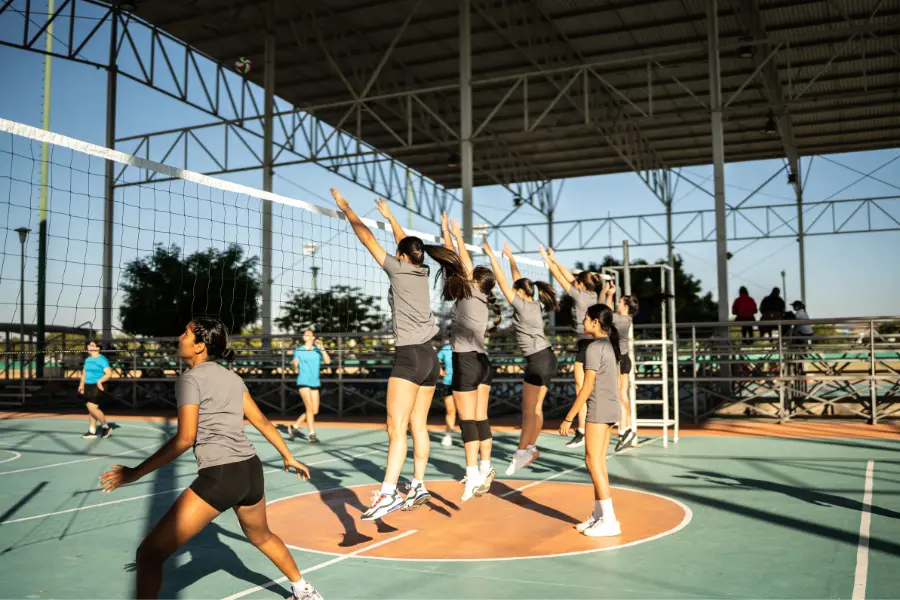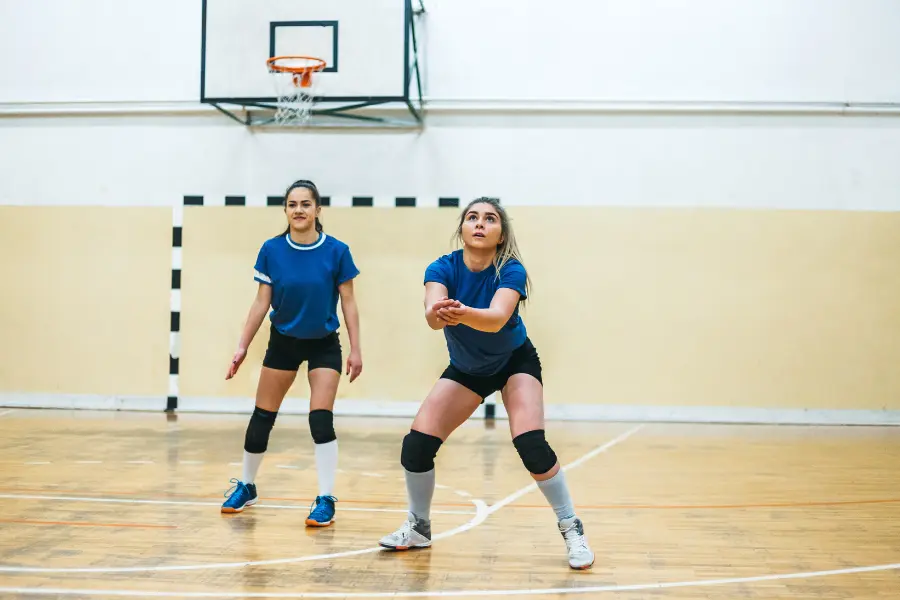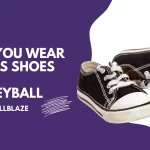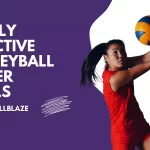Volleyball requires a lot of skills, without a doubt. If you’ve ever watched a college or professional volleyball match, you know the athletes perform well at a fast pace.
In defense, you probably saw some crazy dives and pancakes, while on offense, you probably saw slides, one-steps, C’s, and shoots. While these skills are impressive, you will not be able to utilize them effectively unless you understand the importance of the following Developing Technical Skills For Volleyball.
Developing Technical Skills For Volleyball

Downballs
The highlight videos of 6’3″ outside hitters just pounding the ball have probably made us all wish we could do that, right? The outside hitter was taught to do a downball before they were able to attack the ball like that.
Downballs happen when you attack the ball while standing on the ground without jumping. When you don’t worry about jumping and timing, you can focus on other aspects of hitting well, such as using a guide hand, positioning your feet and body correctly, engaging the ball at the highest point, snapping your wrists, and following through.
When you start approaching and attacking the ball, all of these components will be used – so mastering them early will give you the best chance of success!
Digging
Passing is referred to as digging when you’re playing defense against your opponent’s attacks. It’s crucial to have this skill when you’re trying to keep a rally going and your team has to play very well on defense. It is important to stay low while playing defense in order to dig effectively.
Staying on your toes and keeping your knees bent are key to moving quickly towards the ball. You should also pay attention to where the ball goes and what the ball does so you can determine who is attacking the ball and what type of attack will follow (hard-driven balls, tips, roll shots, etc.). You can adjust your platform based on how fast the ball is coming towards you.
Keep your platform stable and shrug your shoulders to absorb the ball if it is coming quickly. To make a pass reachable for the setter, add a little swing to your platform when you contact the ball if it was tipped.
Serving
Play, games, and matches all begin with a serve. Thus, it comes first on our list of technical skills. Serve over and in consistently before trying any other serve than a standing serve.
Eventually, you will be able to serve jump-floats or jump-top spins once you become consistent. If you don’t have the basic skills to make a standard, standing serve, your jump serves won’t be useful.
You can also aim your serves once you’re consistent with serving. Depending on how your opponent’s serve receive formation looks, you can choose a specific opponent or a specific court number (1, 2, 3, 4, 5 or 6).
Passing
Passing is another essential skill. Similar to the way a game, match, or play begins with a serve, the second touch on the ball is a pass. It’s also your team’s first touch, so the pass needs to be useful for your team.
If your setter is coming from the back row, it is helpful to get the pass up to 15 feet in the air to allow them time to gain access to the ball – in general, you should aim to get the pass up to 15 feet in the air, however a higher pass may be helpful if your setter is coming from the back.
It is up to each team to determine where a “perfect” serve receive pass should go, but in general, pass between the middle hitter and the backside hitter. To prevent your setter from running into your pass, you should place your pass 2-5 feet away from the net.
As well as serve-receive passes, all passes during the game should be directed towards the same area – especially during free balls, when you have the most time to focus on a perfect pass!
Setting
Sets follow passes (hopefully!) if you (the setter) were able to get to the ball on time after the pass. By beating the ball, you can set your body before it reaches your hands.
Once you pinpoint the ball’s location, you need to anticipate where the pass will go and move quickly. It will also allow you to contemplate where you want to set the ball once your body is set. It’s normal to have two options – the outside hitter and the middle hitter – and if you’re setting from the backrow, you’ll also have an opposite hitter.
It’s also important to remember that you can use your backrow teammates as hitting options as well (if you, your coach, and your teammates feel comfortable doing so). As you set, keep in mind who is hitting well at the moment and continue to set them, because if someone gets a really good hit, they will want the next set – so give it to them!
Approach and Attack
When we talked about downballs, remember how important they are? In order to get momentum behind your attack on the ball, you’ll need to master that skill first.
Attackers can use approaches from anywhere on the court by making a few adjustments based on where the set is located and where they are positioned. You have many different approaches, but they all use a few things in common.
Swinging efficiently requires the use of your arms, for instance. You should also balance yourself right before you jump by taking your last two steps. Right-handed and left-handed people will have different approaches because some require three steps and some require four steps. Whenever you need help with these adjustments, ask your coach!
Diving
The majority of volleyball balls do not come right to us – we know this from experience. Sometimes all it takes is one step forward, backward, left, or right to reach the ball. There are times, however, when the ball is beyond our reach and we need to do something else in order to reach it.
That’s when diving comes into play! When diving, we need to be careful because if we don’t dive properly, we could get injured very easily. Ensure that both knees are out sideways when you dive so they won’t be the first things to hit the ground.
The initial impact on the ground will be easier if your dive has some momentum behind it, so that you slide through the dive rather than flopping on it. Ask your coach for some help if you want to learn how to dive properly or check out some YouTube tutorials.
No matter what level of volleyball we play, these technical skills are always necessary. So master them as soon as possible so that you can begin to build your skills!
You may enjoy reading Unsung Hero Of Volleyball Court
What Is A Technical In Sports?

A technical foul in basketball is any foul committed against a non-player during the course of play that is considered a violation of the rules for the purpose of punishing it as a foul.
Technical Vs Tactical Skills
Having technical skills is important for success in many areas, but having tactical skills is quite different. Technical skills are the ability to understand the underlying principles of a particular field, such as engineering, accounting, or programming. As opposed to technical skills, tactical skills focus on solving problems and making decisions in the context of those principles and mechanics.
In order to succeed in most areas, it’s important to have both sets of skills, but it’s also important to know the differences between them. An understanding of technical skills is the basis for understanding the principles and mechanics of a particular field, whereas tactical skills allow you to apply that knowledge.
It can be helpful for you to improve your coaching skills if you understand the difference between technical and tactical skills. Different sports require athletes to use technical skills in order to accomplish specific goals.
It is during the course of games and competitions that elite athletes develop their tactical skills. Athletes can be motivated by understanding their coach’s goals. Observational skills can assist athletes in identifying opposing teams’ strategies, goal opportunities, and teammates who may need assistance. When a coach or captain cultivates strategic thinking, he or she can assist in developing a team’s strategy. In short, technical skills refer to the ability of an athlete to perform certain movements.
Coaches may focus more on game tactics in technical sports. Soccer players should learn common techniques for playing, problem-solving, and visual scanning. Captains of more advanced teams may be able to delegate some strategic monitoring.
By modeling effective strategies, the captain can assist other players in developing their tactical skills. It may be necessary for the coach to develop a variety of training exercises if he or she wishes to master tactical skills. The most effective way to develop technical skills is to play a specific sport or a sport closely related to it. Athletes who have mastered tactical skills can transfer those skills to other sports.
You may enjoy reading How to Play Beach Volleyball?
Coaching Volleyball Technical

A technical volleyball coach teaches athletes the fundamentals of the game, including passing, setting, spiking, serving, and blocking. It is essential to understand the basics of the game, as well as the strategies and tactics of the team.
In order to develop and improve players, coaches must be able to identify their strengths and weaknesses. To coach technical volleyball, you must have patience, communication skills, and the ability to motivate and inspire players. In order for a team to achieve its goals, a coach needs to combine technique and knowledge.
The volleyball coach Cecile Reynaud is the head of the Volleyball Technical and Tactical Skills program. Throughout her 25-year career, she earned numerous awards for her NCAA Division I volleyball record of over 600 victories. In this book, served, hit, blocked, and defended are all discussed in sections similar to those in For Dummies.
This course focuses on volleyball’s technical aspects in the first section. Teaching and evaluation are covered in the first section, followed by technical and tactical subjects. In the fourth section, you will learn how to develop your practice and season plans.
You may enjoy reading Volleyball Passing Platform
Conclusion
As a volleyball player, developing technical skills requires dedication, practice, and a desire to continually improve and learn. Your game can be elevated to new heights by focusing on fundamental techniques and honing your serving, passing, and attacking abilities.
Strive for excellence on the volleyball court by setting realistic goals, seeking feedback from coaches and teammates, and embracing the process of skill development.
You may enjoy reading What is a Tip in Volleyball?





